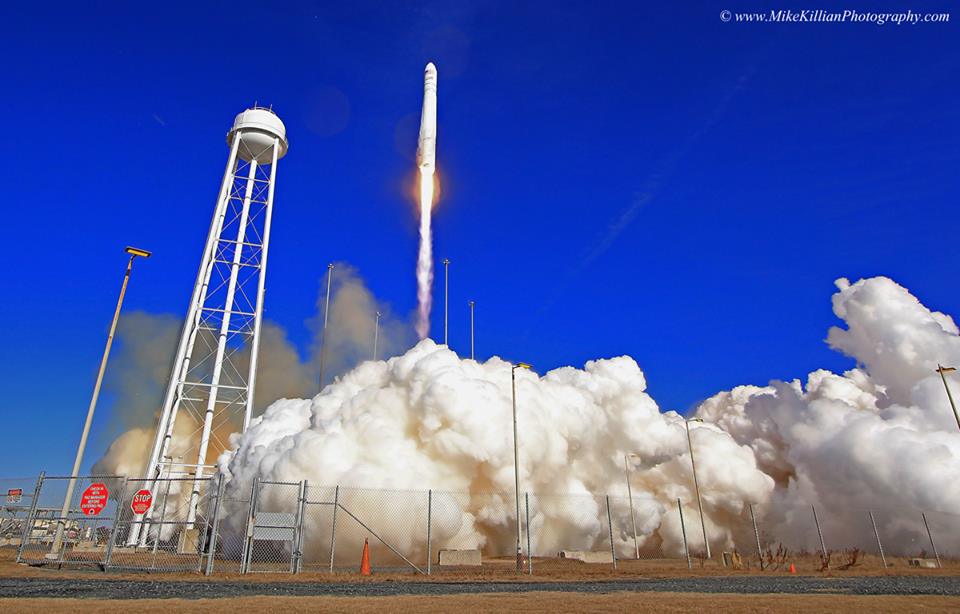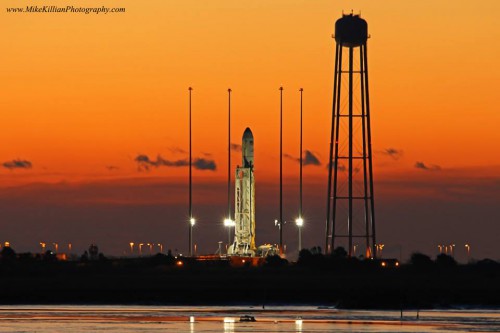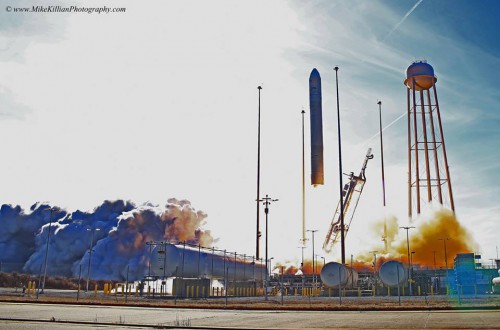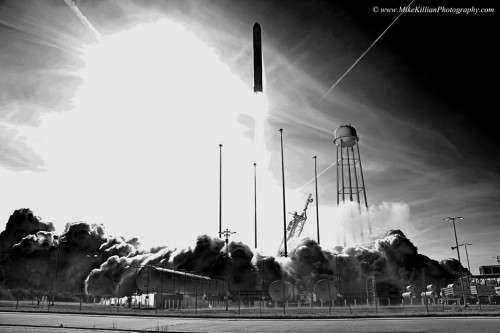
Twenty-four hours later than planned, Orbital Sciences Corp. has successfully launched its first dedicated Cygnus cargo ship toward the International Space Station (ISS). Liftoff of the ORB-1 mission took place at 1:07 p.m. EST Thursday from Pad 0A at the Mid-Atlantic Regional Spaceport (MARS) on Wallops Island, Va., at the opening of a five-minute “window.” The Cygnus was boosted into low-Earth orbit by Orbital’s home-grown Antares rocket, which was making its third mission, and the spacecraft is tracking a rendezvous and berthing at the space station’s Harmony node early Sunday, 12 January.Today’s launch has been a long time coming. Last month, on 11 December, the starboard pump module on one of the space station’s external ammonia coolant loops automatically shut down when it reached pre-set temperature limits, prompting a postponement of Cygnus’ planned 19 December liftoff and a pair of lengthy EVAs by Expedition 38 astronauts Rick Mastracchio and Mike Hopkins during Christmas week to remove and replace the failed hardware. A new target launch date of 7 January was announced, but that too slipped by 24 hours, due to predicted cold temperatures at the MARS site on the Virginia coast. Another attempt yesterday (Wednesday) was called off, following elevated levels of space radiation caused by a massive X-class solar flare on Tuesday.
After examining the situation—including the potential impact to the electronics aboard Antares and Cygnus—both Orbital and NASA felt sufficiently comfortable by Wednesday afternoon to press ahead with today’s launch attempt. “Orbital conducted a comprehensive review of data related to the radiation environment in space, further reviews and modeling of the rocket’s avionics systems and the forecast for favorable terrestrial weather conditions,” NASA reported. “Upon a deeper examination of the current space weather environment, Orbital’s engineering team, in consultation with NASA, has determined that the risk to launch success is within acceptable limits established at the outset of the Antares program.”

Final countdown operations commenced early this morning, with meteorological conditions predicted to be 85 percent favorable, with partly cloudy and sunny weather along the Virginia coast. At 9:50 a.m. EST, the Flight Termination System (FTS)—tasked with destroying the vehicle in the event of a major malfunction during ascent—was powered up and underwent standard tests before being transferred to internal power. Shortly thereafter, a regulator issue cropped up and an Orbital engineering team was despatched to Pad 0A to investigate the problem. This resulted in a slight delay in clearing the launch complex of all essential personnel. Then, a liquid oxygen leak was identified, but according to an Orbital tweet, it was centered on a maintenance line, was properly checked out, and did not pose a threat to the countdown. By 11:10 a.m., the issue had been cleared.
By now inside the final two hours ahead of launch, the process of chilling down the liquid oxygen lines aboard Antares began, preparatory to loading oxidizer aboard the 133-foot-tall (40-meter) rocket to feed its twin AJ-26 first-stage engines. Weather conditions remained a concern, with upper-level winds trending in the wrong direction, but, following a satisfactory response from balloon data, at 11:35 a.m. the status changed to “Green” (“Go”). The mission was not yet entirely out of the woods, however, for a Distant Focusing Overpressure (DFO) issue kept the Range as “Red” (“No-Go”). DFO is described as an atmospheric phenomenon which can produce enhanced overpressures due to sonic velocity gradients at altitude, which carry the likelihood of breaking windows and possibly causing personal injuries. Although it occurs only under certain meteorological conditions, it was of sufficient severity to keep the Range at “Red” until the final minutes of today’s countdown.
In the meantime, the Orbital team issued a “Go” to begin tanking, and after an initial phase of chilling the fuel lines, the liquid oxygen and rocket-grade kerosene fuel (known as “RP-1”) were pumped into Antares’ tankage. Propellant loading aboard Antares is timed to begin about T-90 minutes, due to time limits associated with the rapid boil-off of the cryogenics. This produced a state with all propellant levels declared to be “Flight Ready,” and the liquid oxygen remained in a “topping off” mode, being continuously replenished until just before liftoff. The vehicle’s flight software was loaded into its computerized brain, and open-loop telemetry underwent final tests. The DFO issue was finally reclassified as “Green” at about 12:53 p.m.—less than 15 minutes before the opening of the launch window—and the final terminal countdown poll of flight controllers at 12:55 p.m. produced a unanimous “Go for Launch,” with all stations now reporting as “Green,” across the board.

As the countdown ticked into its final 10 minutes, Antares’ and Cygnus’ systems transitioned to internal power and the Transporter-Erector-Launcher (TEL) “strongback” was armed to execute a rapid retraction at the instant of liftoff. The chilling-down of the AJ-26 engines on the first stage moved to medium flow in order to provide final conditioning, ahead of the ignition sequence. Avionics transferred to internal power at 1:02 p.m., and the Autosequencer assumed primary command of all vehicle critical functions at 1:03 p.m. By T-2 minutes, the rocket’s propellant tanks were confirmed at flight pressure and the engines underwent a period of gimbaling to confirm their readiness to support Antares’ climb to orbit.
Precisely on time, at 1:07:06 p.m. EST, the AJ-26 engines roared to life, steadily ramping up to full power, as computers constantly monitored their performance. All was well. At T+2 seconds, at 1:07:08 p.m. EST, the hold-down clamps were released and Antares took flight, rocketing away from Pad 0A. Although this represents the second Cygnus mission to the ISS, following the ORB-D demonstration in September-October 2013, it is Orbital’s first “dedicated” cargo supply flight, under the provisions of a $1.9 billion Commercial Resupply Services (CRS) contract, signed with NASA back in December 2008. According to the language of that contract, Orbital will stage eight CRS missions by 2016 to deliver payloads and supplies to the ISS. With SpaceX having already completed its own demonstration flight of its Dragon cargo ship in May 2012, followed by two dedicated CRS missions in October 2012 and March 2013, the United States now has two fully fledged private contractors restocking the space station.
Seconds after clearing the tower, Antares executed a pitch and roll program maneuver to establish itself onto the proper flight azimuth for insertion into a low-Earth orbit, inclined 51.6 degrees to the equator. Maximum aerodynamic turbulence (known as “Max Q”) was encountered about 80 seconds into the flight, and the AJ-26 engines continued to burn hot and hard until they finally shut down about four minutes after launch. At an altitude of about 70 miles (110 km), and traveling in excess of 10,000 mph (16,000 km/h), the first stage separated at 1:11 p.m. EST. This left the second stage and Cygnus to coast for two minutes, prior to jettisoning the bullet-like payload shroud. Ignition of the second stage’s solid-fueled Castor-30B engine—making its first flight on this launch—occurred soon afterward to inject Cygnus into low-Earth orbit. The cargo ship separated from the second stage about 10 minutes after launch. “This has just occurred above the Atlantic Ocean, east of Brazil,” noted AmericaSpace’s Launch Tracker. “The Cygnus resupply ship will soon deploy its solar arrays and start a series of system checkouts as its orbit is raised to a meeting with the ISS.”

Over the next 72 hours, Cygnus will perform several orbit-raising and “phasing” maneuvers to bring it into the neighborhood of the space station early on Sunday, 12 January. In a manner not dissimilar to September’s ORB-D mission, the ORB-1 profile will see Cygnus showcase its ability to “hold” position at various distances before entering the Keep-Out Sphere—a virtual exclusion zone, extending about 660 feet (200 meters) around the space station to prevent a collision—and being grappled by Canadarm2 at about 6:02 a.m. EST Sunday. Under the control of Expedition 38 crewmen Mike Hopkins, Koichi Wakata, and Rick Mastracchio, it will be berthed onto the “nadir” port of the Harmony node.
After opening the hatches—probably on Monday—the crew will begin the laborious effort to unload about 2,800 pounds (1,300 kg) of supplies and equipment. Current plans call for Cygnus to remain berthed at the ISS until “mid-February,” at which time it will be robotically detached and later commanded to execute a destructive re-entry into the upper atmosphere. Its mid-February departure, NASA explained, will clear the way for SpaceX’s CRS-3 Dragon mission. In so doing, it will dispose of about 2,200 pounds (1,000 kg) of waste.
Like September’s ORB-D mission, which was named for former Orbital executive G. David Low, the upcoming flight of ORB-1 pays tribute to another shining light in the company’s fortunes. It will bear the name “Spaceship C. Gordon Fullerton” to honor the former shuttle astronaut and research pilot who died last year. Assuming a successful ORB-1 mission, Orbital plans two further Cygnus flights in 2014, with ORB-2 scheduled for May and ORB-3 for October.
Want to keep up-to-date with all things space? Be sure to “Like” AmericaSpace on Facebook and follow us on Twitter: @AmericaSpace



